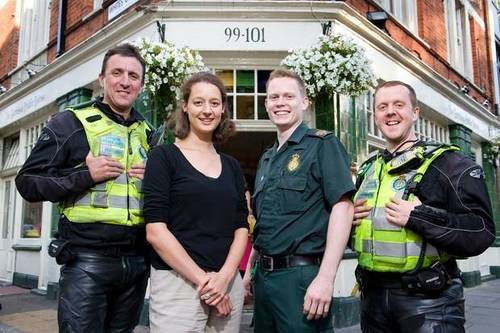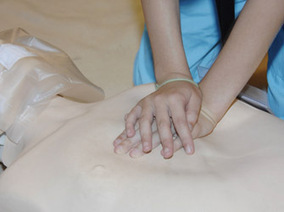See on Scoop.it – Defibrillation
The latest scientific studies show the importance of the bystander as a first responder
(HealthNewsDigest.com) – Sudden cardiac arrest (SCA) differs from a heart attack in a couple of important ways. First, SCA is the leading cause of death in the U.S., according to the Mayo Clinic, and is more common than heart attack. Second, SCA can be successfully treated by a bystander with an automated external defibrillator (AED), according to several peer-reviewed medical studies.
Virtually every day in America, AED technology enables an individual with little or no medical training to save the life of another human being. This fact makes SCA unique among other leading causes of death such as heart attack, stroke and cancer – afflictions that require interventions from medical professionals.
SCA is an arrhythmia – an electrical disorder of the heart – that can be corrected by a shock from an AED. Heart attack is caused by a blocked artery, which must be cleared or bypassed in a medical facility. Still, only about 8 percent of about 380,000 annual SCA victims in America survive to hospital discharge – primarily because they do not receive shocks quickly enough from an AED. This 8 percent survival rate is dismal, especially when compared to the roughly 85 percent survival rate of heart attack victims.
In any workplace, every employee can be and should be a potential lifesaver.
Too often, workers suffer SCA and die because a defibrillator is not available in time to save them. Conversely, about 90 percent of SCA victims who receive shocks within the first minute after arrest survive, according to the Sudden Cardiac Arrest Association. The chances of survival decrease by 7 to 10 percent with each passing minute. After 10 minutes, less than 5 percent of victims survive.
The aggregate SCA survival rate, recorded across various populations, has remained around 8 percent for the past 30 years, according to a study published in the American Heart Association’s Circulation: Cardiovascular Quality and Outcomes. However, the authors noted that survival was “greatest in locations in which a defibrillator is available.” They also said that because most out-of-hospital cardiac events are witnessed, efforts to improve survival should focus on the prompt use of an AED and CPR by those who witness the event.
While receiving AED/CPR training obviously has its benefits, a Johns Hopkins study published in the Journal of the American College of Cardiology emphasized that “speed is more important than training.” In a review of 13,759 out-of-hospital cardiac arrests, the authors found an average survival rate of 7 percent. However, the survival rate increased to 38 percent when patients received an AED shock before EMS arrival. Non-medical volunteers operating the AED achieved the highest survival rate (40%), followed by healthcare workers (16%) and police (13%). “On average, early AED defibrillation before EMS arrival seems to nearly double a victim’s odds of survival after OHCA,” the authors wrote.
Speed saves
With speed recognized as the most important aspect of AED lifesaving, the focus shifts away from relying on EMS response to having AEDs available in workplaces and public places. While AED/CPR-trained individuals are sometimes present in these areas, SCA victims are often rescued by untrained bystanders.
These Good Samaritans use AEDs successfully, even though they may have never used them before. A survey of 1,018 travelers from 38 nations passing through the Amsterdam central railway station found that roughly half of these individuals would be willing to use an AED in an emergency. Among those expressing reluctance, the most common barriers to using an AED were a lack of knowledge of how to work the AED and concerns about harming the victim.
Approaching the tipping point to higher SCA survival
Today, AEDs are approaching a tipping point similar to the one that happened with the introduction of the iPhone. Before Apple launched this product, most consumers were intimidated by smart phones. The iPhone made smart phones easy – this innovation and its impact on other manufacturers made text and email by phone commonplace, turned mobile devices into the most common way to access the Internet, and merged it all with music, video and a world of apps. Now, many people manage their lives from their smart phone.
In a similar fashion, new AED technology merges audio, video, training and maintenance capabilities into an easy-to-use lifesaving device that inspires confidence in the minds of potential rescuers. A survey by AED designer and manufacturer Defibtech and Harris Interactive asked the question: In addition to audio instruction (provided by the AED during a rescue situation), what would give you greater confidence to use an AED? The answer? Video. With video, text and voice, 97 percent of the respondents said they would be able to use an AED to save a life.
In response, Defibtech introduced the VIEW AED, which has an innovative, exclusive LCD video feature that literally shows rescuers how to perform each step of an SCA rescue in real time – in accordance with the latest American Heart Association (AHA) guidelines. The color video is reinforced by loud and clear audio and corresponding text that can be understood in noisy environments. For example, when the VIEW’s audio says and text reads, “Place pads on patient’s chest,” the video shows exactly where to place the pads.
The VIEW also has embedded help videos that can be used during training to review the critical steps of a rescue, providing reassurance to rescuers that they will be ready during the stress of an emergency. In addition to the help videos, the VIEW has a patented status screen that shows the readiness of defibrillation pads and the AED’s battery, as well as the overall AED operational status. The VIEW AED virtually maintains itself through automated daily self-tests. Choosing an AED that’s easy for bystanders to use is important because not all AEDs are created equal.
Enable your workers to rescue a fellow employee
From any standpoint, it makes complete sense to encourage and enable workers to rescue a fellow employee striken by the most common killer of Americans. While medical advances in virtually every area of medicine have reduced mortality rates, SCA mortality has remained the same for 30 years, even though it can be treated by a person with no medical training if there is an AED onsite. That fact alone calls for workplaces to have AEDs available and to empower their employees with the confidence to use them.
Greg Slusser is a vice president for Defibtech, the designer and manufacturer of the Lifeline™ and ReviveR™ families of AEDs and related accessories, Click Here 1-866-DEFIB-4-U (1-866-333-4248).
Abridged with permission from the August 2012 edition of Facility Safety Management magazine (www.fsmmag.com)
See on www.healthnewsdigest.com

 Follow
Follow





